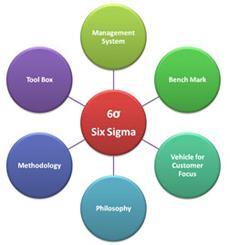“The business of business is to stay in business.”
Dr. Peter Drucker
“The business of business is to stay in business.”
Dr. Peter Drucker

Although the tools used in Six Sigma are century old, the integration of the concepts and methods were by Bill Smith, Motorola Quality Engineer began implementation at Motorola in 1986. That had helped Motorola to win the first Baldrige Award in 1988. Since then quality engineers pursuing productivity improvement world-over took cue from this proven success methodology. It would be unjust to mention only few names of those companies who have adopted Six Sigma. Six Sigma is adopted almost in every sector & industry across the globe irrespective of their size, nature and volume of business as their means to manage their process and improve operational performance & efficiency.
In the past, quality programs such as TQM adopted by organisations focused on 'meeting customer's needs' without due consideration of visible and invisible costs. Thus, many organisations managed to produce high quality goods, but at comparatively high cost. However, today in the fiercely competitive market, organisations have no choice but to offer the best quality products and services at the minimum cost - which is the purpose and objective of Six Sigma.
Six Sigma is a system of management that utilises information (management by facts) and statistical analysis to measure and achieve breakthrough improvement in a company's operational performance, practices and systems
Six Sigma, in many organisations simply means a measure of quality that strives for near perfection: only 3.4 Defects per Million opportunities - a near perfect quality.
6-Sigma quality is a benchmark; 5-Sigma is World class; Current industry averages between 3.5 to 4.0 Sigma.
Sigma capability can be computed for all types of processes, manufacturing or service and hence it is used as a performance metric.
Six Sigma is a vehicle which drives you towards your customer satisfaction and delight by synchronising the activities of entire organisation to that of customer needs.
Customer Critical To Quality (CTQ) Criteria
Breakthrough Improvements
Fact-driven, Measurement-based, Statistically Analyzed Prioritisation
Controlling the Input & Process Variations Yields a Predictable Product
Variation is enemy of a process.
Reduce variation in your business and take customer -focused, data driven decisions.
The methodology is popularly known as DMAIC (Define - Measure - Analyse - Improve - Control), It's a systematic approach which ensures sustained improvement.
An umbrella covering simple tools to advanced statistical analysis, the knowledge of tools and their application is the key success factor It converts a practical problem to Statistical problem, through use of analytical tools It generates statistical solutions, which are then converted to practical solutions.
SBS has successfully deployed Six Sigma methodology in many of its Business Improvement Projects at various clients of diverse industrial spectrum. We carefully strategise & structure the launch of Six Sigma initiative in select part or throughout the organisation and closely work to launch Six Sigma Movement. As part of the movement, we train key personnel, select suitable projects and monitor the results. Our leadership practice is designed to help leaders identify the most effective ways to transform their organisations.
Please visit our training services under Productivity for